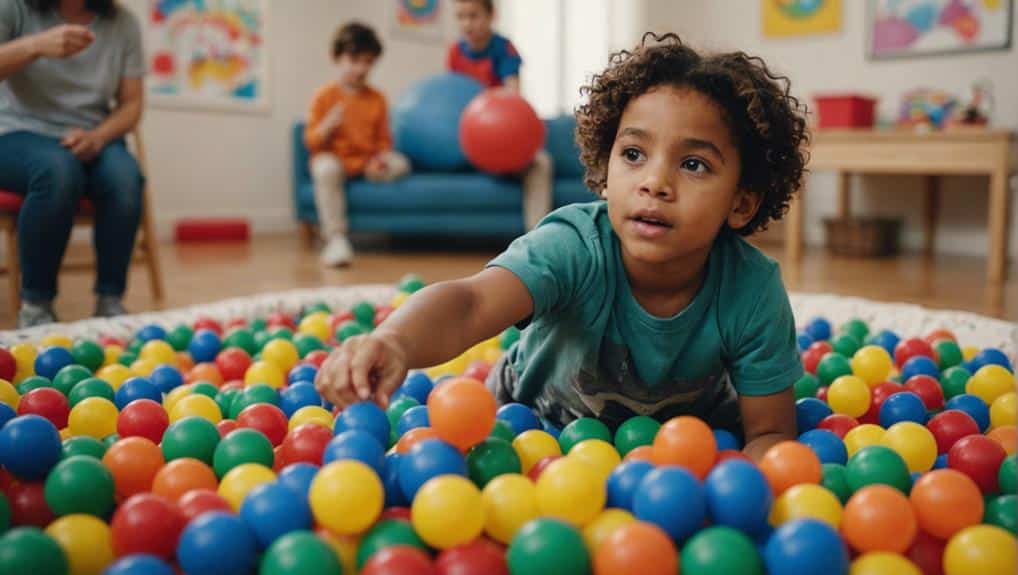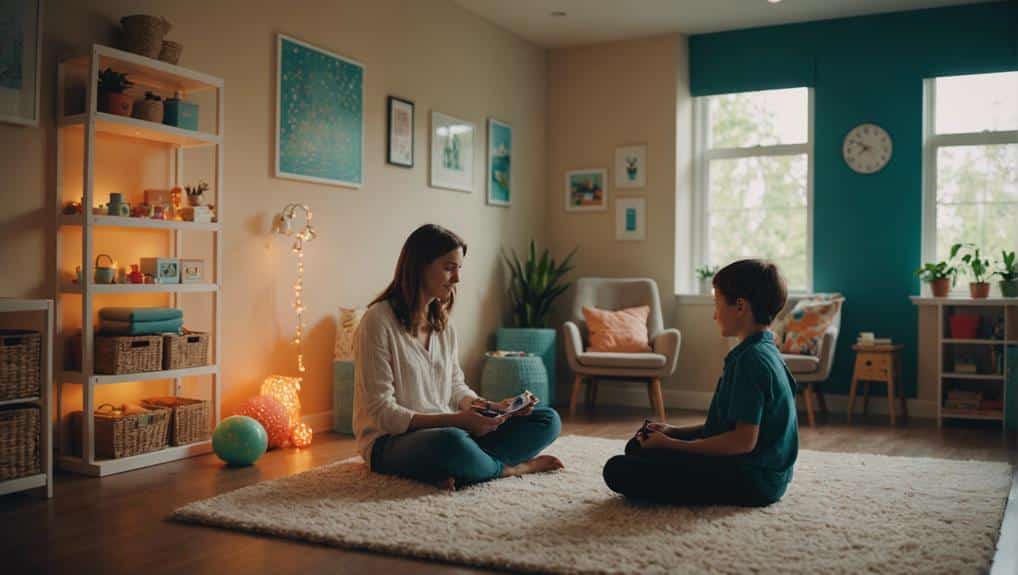Sensory Integration Therapy (SIT) is a proven method to help children with autism who have sensory processing issues. Skilled occupational therapists use fun activities like swinging and brushing to improve sensory processing. These activities help kids manage their responses to different sensory inputs, which can reduce behavior problems and make everyday tasks easier. As a result, children can improve sensory processing, which leads to better social interactions and emotional control.
These personalized techniques allow kids to adapt better to sensory stimuli, boosting their independence and quality of life. SIT not only helps with managing hypersensitivity or hyposensitivity but also supports overall emotional regulation. By using tailored strategies, children can improve sensory processing, making navigating their world more manageable.
Key Takeaways
- Sensory Integration Therapy helps autistic children manage hypersensitivity or hyposensitivity to sensory stimuli.
- It enhances sensory processing abilities, improving social interactions and regulating behavior.
- Personalized activities improve sensory modulation and reduce anxiety in children with autism.
- Occupational therapists create tailored intervention plans to address specific sensory challenges in autistic children.
- Parent involvement in SIT promotes skill generalization and provides emotional support, boosting the child’s confidence.
Discover Sensory Processing Therapy
Sensory Integration Therapy (SIT) is an evidence-based intervention trained occupational therapists administer to aid children with autism in effectively processing and integrating sensory information. The primary objective of SIT is to address sensory processing difficulties that often impede daily functioning and participation in activities. Occupational therapy (OT) professionals utilize a tailored approach, designing personalized sensory experiences that target specific sensory challenges experienced by each child.
SIT incorporates various physical activities and exercises, allowing children to engage with sensory inputs in a controlled and structured environment. These activities may include swinging, balancing, or tactile play, carefully selected to elicit appropriate sensory responses. By engaging in these experiences, children can improve their ability to interpret and respond to sensory information, fostering better self-regulation and a more nuanced understanding of their surroundings.
The therapeutic techniques employed in SIT aim to enhance the child’s sensory processing abilities, ultimately contributing to improved behavior management and increased participation in everyday activities. This intervention empowers children to navigate their sensory world more efficiently, promoting autonomy and enhancing their quality of life.
Therefore, SIT is a pivotal component in the OT arsenal for supporting children with autism.
Sensory Challenges in Autism
Children with autism often face overwhelming sensory inputs due to unusual sensory processing, which can significantly impact their ability to engage in everyday activities.
These sensory processing differences can lead to heightened stress and avoidance behaviors, further complicating social interactions and learning opportunities.
Addressing these sensory challenges is essential for enhancing their functional and developmental outcomes.
Overwhelming Sensory Inputs
Autistic people often face overwhelming sensory inputs, manifesting as either hypersensitivity or hyposensitivity to stimuli such as light, noise, and tactile sensations. These sensory processing challenges can profoundly impact their daily functioning and contribute to behavioral difficulties. Sensory integration therapy (SIT) addresses these issues by helping autistic children adjust to and process sensory information more effectively.
SIT employs various therapeutic techniques to manage overwhelming sensory inputs. Interventions such as swinging, brushing, and playing in a ball pit are designed to engage children’s sensory systems in a controlled manner, thereby improving their sensory processing capabilities. These activities help reduce anxiety and promote a sense of agency and freedom in children.
Evidence-based practices in SIT emphasize tailored environmental modifications and sensory diets personalized to specific needs. These interventions are essential for creating an ideal sensory environment to mitigate hypersensitivity.
Play-based activities are another critical component, allowing children to explore and adapt to various sensory experiences in a structured yet enjoyable manner. Through these methods, sensory integration therapy offers a pathway to manage sensory processing challenges in autistic children better.
Sensory Processing Differences
Understanding sensory processing differences is fundamental to addressing the unique challenges faced by children with autism. Approximately 90-95% of individuals with autism experience difficulty processing sensory information, which can have a notable impact on their social communication and behavior.
Sensory processing difficulties often worsen social communication deficits and repetitive behaviors, adding to the complexity of managing autism spectrum disorder (ASD).
Sensory integration therapy, often facilitated by occupational therapy professionals, aims to mitigate these challenges by helping autistic children better interpret and respond to sensory inputs. This therapeutic approach is grounded in evidence-based practices designed to enhance the brain’s ability to process and organize sensory information.
Occupational therapy interventions focus on creating tailored activities that promote effective sensory integration. Such activities might include swinging, balancing, and tactile exploration, intended to improve the child’s ability to participate in everyday activities.
Through consistent therapy, children may experience behavioral, social, and educational improvements, fostering greater independence and quality of life.
Impact on Daily Life
The widespread sensory challenges experienced by people with autism significantly impact their ability to participate in daily activities and social interactions. Approximately 90-95% of autistic individuals encounter difficulties in processing sensory information, which can lead to significant barriers in their daily lives. These sensory difficulties manifest in various forms, such as hypersensitivity to sounds, textures, or lights, overwhelming ordinary situations, and often isolating individuals and their families.
Addressing these sensory challenges is essential to improving the quality of life for autistic children. Sensory integration therapy (SIT) is an evidence-based approach to enhance brain processing and responding to sensory information more effectively. Through structured and repetitive activities that stimulate the senses, SIT helps children develop better adaptive responses, thereby reducing sensory overload.
Benefits of Sensory Integration Therapy

Sensory integration therapy has shown significant promise in enhancing sensory processing capabilities in children with autism, thereby facilitating a more cohesive interaction with their environment.
This improvement in sensory integration can lead to better social interactions by reducing sensory overload and associated behaviors.
Evidence-based studies indicate that these benefits extend to aiding feelings regulation and improving play skills, which are essential components of child development.
Enhances Sensory Processing
Sensory integration therapy markedly enhances sensory processing abilities in autistic children by facilitating the practical interpretation and utilization of sensory information. This therapeutic approach addresses sensory issues by helping children effectively combine sensory inputs, such as sight, sound, touch, and movement, into a coherent understanding of their environment.
Sensory integration therapy employs evidence-based techniques targeting sensory processing abilities to mitigate the challenging behaviors often associated with sensory overload or deficits.
Clinicians utilize specific and personalized activities to stimulate the vestibular, proprioceptive, and tactile systems. Children learn to modulate sensory experiences more effectively through repeated exposure and carefully structured exercises. This modulation helps reduce adverse reactions to sensory stimuli, thereby decreasing the occurrence of challenging behaviors.
Research has shown that children undergoing sensory integration therapy exhibit improved regulation of their sensory responses. This leads to better adaptive behaviors and a more seamless interaction with their surroundings.
To summarize, sensory integration therapy provides a structured yet flexible framework that empowers autistic children to process sensory information more efficiently, ultimately fostering greater autonomy and well-being.
Improves Social Interaction
Enhancing social interaction in children with autism, sensory integration therapy effectively reduces sensory sensitivities and fosters better engagement in social activities. Through a structured approach, Sensory Integration (ASI) therapy helps children regulate sensory input, vital for their ability to participate comfortably in social settings. By addressing the sensory challenges that often overwhelm children with autism, ASI therapy creates a foundation for improved social communication skills.
Therapeutic techniques employed in ASI therapy focus on personalized sensory experiences that help children adapt to and manage sensory stimuli. This reduction in sensory sensitivities enables children to engage more freely in social interactions. Evidence-based studies support that children participating in ASI therapy exhibit enhanced social behaviors and an increased willingness to interact with peers and adults.
The therapy promotes positive social interactions and supports the development of meaningful social relationships. As children become more comfortable in social environments, they can better engage in activities that require cooperation and communication. This increased comfort and adaptability significantly contribute to their overall social development, enhancing their quality of life and fostering independence. Sensory Integration therapy becomes a pivotal tool in helping autistic children navigate the complexities of social interactions.
How SIT Works
Sensory Integration Therapy (SIT) frequently employs structured, play-based activities to address sensory processing issues in children with autism systematically. This therapeutic approach, often facilitated by an occupational therapist, focuses on helping children manage and integrate various forms of sensory input more effectively.
By engaging in activities designed to target specific sensory processing difficulties, children can improve their responses to sensory stimuli, enhancing their daily functioning and overall quality of life.
The SIT process involves a series of carefully planned interventions that aim to modulate sensory integration, making it easier for children to cope with sensory challenges. The occupational therapist tailors these interventions to each child’s distinct sensory needs. This personalized approach ensures the therapy is practical and engaging for the child.
To highlight critical aspects of SIT:
- Enhances sensory processing abilities
- Improves adaptive responses to sensory stimuli
- Promotes better integration of sensory input
- Facilitates greater independence in daily activities
- Reduces sensory-related behavioral issues
Ultimately, Sensory Integration Therapy is an evidence-based methodology designed to assist children with autism in achieving greater sensory harmony and enhancing their ability to navigate their environments’ sensory complexities.
Types of Sensory Activities

Sensory Integration Therapy encompasses a variety of sensory activities, such as swinging, brushing, and playing in a ball pit, which are strategically designed to enhance sensory processing in children with autism. These activities are foundational in occupational therapy (OT), providing targeted sensory experiences to help children adapt to multiple sensory stimuli. For instance, swinging can improve vestibular processing, brushing techniques may help in tactile desensitization, and ball pits can enhance proprioceptive input.
These interventions aim to improve focus and behavior and reduce anxiety by incorporating an individualized plan, a tailored sensory activity plan. Sensory diets include various activities and environmental modifications tailored to each child’s sensory needs. Environmental modifications might involve using white noise machines to control auditory stimuli, creating a more conducive atmosphere for sensory processing.
The ultimate Goal of these sensory activities is to foster bGoalr adaptation to sensory inputs, thereby enhancing daily functioning. By integrating these diverse sensory experiences, OT practitioners can systematically address the sensory integration challenges faced by children with autism, empowering them to navigate their environments more effectively and autonomously.
Role of Occupational Therapists
Occupational therapists are crucial in sensory integration therapy, developing personalized intervention plans that address the individual sensory processing challenges of each child with autism.
They utilize evidence-based sensory processing techniques to facilitate the child’s ability to interpret and respond effectively to sensory stimuli.
Moreover, occupational therapists engage in a collaborative family approach, ensuring that therapeutic strategies are seamlessly integrated into the child’s daily life.
Tailored Intervention Plans
Therapists meticulously craft personalized sensory integration therapy plans to address the specific sensory processing difficulties experienced by children with autism. Occupational therapy (OT) professionals play a pivotal role in developing these tailored intervention plans designed to improve sensory processing, reduce challenging behaviors, and enhance daily functioning.
Occupational therapists employ a systematic approach to identifying specific sensory-motor factors that interfere with a child’s ability to effectively process and integrate sensory information.
The implementation of these customized plans involves:
- Evaluation: Conduct a thorough assessment to understand each child’s sensory processing challenges.
- Tailoring: Designing intervention strategies tailored to the child’s needs and preferences.
- Evidence-Based Techniques: Utilizing proven therapeutic methods to facilitate better sensory integration.
- Family Engagement: Collaborating with families to maintain consistency and provide support across different environments.
- Progress Monitoring: Continuously evaluate the child’s development and adjust the intervention plan as necessary.
These tailored intervention plans enable autistic children to interpret and utilize sensory inputs more effectively, supporting their ability to navigate the world.
Through dedicated and individualized OT strategies, children with autism can achieve greater independence and overall well-being.
Sensory Processing Techniques
Therapists employ a variety of sensory processing techniques to address the unique sensory challenges faced by children with autism. They utilize activities such as swinging, brushing, and playing in a ball pit to enhance sensory integration and improve daily functioning. These occupational therapy (OT) techniques are clinically designed to assist in mitigating sensory processing disorder, a common issue among autistic children.
Occupational therapists (OTs) trained in sensory integration therapy utilize evidence-based interventions to help children better process and respond to sensory stimuli. Swinging can enhance vestibular processing, brushing can provide deep pressure input to calm the nervous system, and playing in a ball pit offers proprioceptive feedback, all of which are critical sensory strategies to enhance sensory processing capabilities.
These sensory strategies are not just recreational; they aim to reduce sensory reactivity, improve focus, reduce anxiety, and enhance participation in daily activities. By incorporating these targeted activities, OTs facilitate improved behavioral responses and greater engagement in various life skills.
Sensory integration therapy serves as a cornerstone of occupational therapy, providing a structured, therapeutic approach for managing sensory processing disorder in children with autism, ultimately promoting greater autonomy and quality of life.
Collaborative Family Approach
Occupational therapists guarantee that sensory integration therapy is tailored to the specific needs and goals of each autistic child by engaging in a collaborative family approach. This family-centered methodology ensures that the therapeutic plans are personalized and all-encompassing, providing a thorough support system that enhances the child’s daily functioning and quality of life.
Occupational therapists work closely with families to set realistic and achievable goals. This collaboration allows for a thorough understanding of the child’s distinct sensory processing challenges and facilitates the development of targeted interventions. By consistently evaluating progress and adjusting therapy plans, occupational therapists ensure the fidelity of sensory integration therapy.
Key elements of the collaborative family approach include:
- IndividuaIndividualized Establishing personalized objectives through consultation with the family.
- Regular Progress Evaluations: Continuously monitoring and appraising the child’s development.
- Tailored Interventions: Adapting therapeutic techniques to meet specific sensory processing needs.
- Parental Involvement: Engaging parents in the therapy process to reinforce strategies at home.
- Holistic Support: Addressing the child’s overall quality of life, not just sensory issues.
Adopting a collaborative family approach, occupational therapists enhance the effectiveness of sensory integration therapy, empowering families and promoting greater autonomy for children with autism.
Choosing a Qualified Practitioner

Selecting a skilled provider for sensory integration therapy involves ensuring that the occupational therapist has specific training and experience in working with children with autism. It is vital to choose a practitioner who is proficient in occupational therapy (OT) and has advanced training in Ayres Sensory Integration—a framework explicitly designed to address sensory processing difficulties common in children with autism spectrum disorder (ASD). The therapist’s ability to tailor sensory integration therapy for autistic children can significantly impact the therapy’s effectiveness.
When evaluating potential therapists, ensure they possess certifications or credentials in sensory integration therapy. This certification ensures they adhere to evidence-based practices and sensory integration principles essential for achieving excellent outcomes. Recommendations from other parents of children with ASD who have successfully navigated sensory challenges through therapy can also be invaluable in making a well-informed choice.
Furthermore, it is crucial that the therapist demonstrates a deep understanding of the specific sensory needs of autistic children and utilizes therapeutic techniques grounded in clinical expertise. Verifying these qualifications ensures that the chosen practitioner can deliver high-quality, effective care tailored to your child’s sensory integration needs.
Parent Involvement in SIT
Parental involvement in sensory integration therapy (SIT) enhances therapeutic outcomes for children with autism. Research consistently demonstrates that active participation from parents leads to better progress and more effective generalization of skills acquired during therapy sessions. Occupational therapists often collaborate with parents to educate them on specific sensory activities tailored to their child’s needs, reinforcing therapy benefits.
Critical aspects of parent involvement in SIT include:
- Enhanced Skill Generalization: Consistent practice of sensory activities at home helps children generalize skills learned in therapy to everyday settings.
- Increased Engagement: When parents are involved, children are more likely to engage in therapy, fostering a supportive and conducive environment for sensory processing improvements.
- Informed Decision-Making: Parents who understand the therapeutic techniques can make informed decisions about continuing or adjusting the therapy plan.
- Consistency and Routine: Regular involvement ensures sensory activities are integrated into the child’s daily routine, promoting stability and progress.
- Emotional Support: Parental support and encouragement play a significant role in the child’s confidence and willingness to participate in sensory activities.
Home-Based Sensory Strategies

Expanding on the significance of parental involvement in sensory integration therapy, incorporating home-based sensory strategies can further support the therapeutic progress of children with autism. Creating a sensory-friendly environment tailored to specific sensory needs is essential. This can include using calming colors, particular textures, and appropriate lighting to reduce overstimulation.
A visual schedule or routine helps children anticipate and manage daily activities, reducing anxiety and promoting a sense of control. Sensory tools, such as weighted blankets, fidget toys, and sensory bins, serve as instrumental aids in providing comfort and regulation. These tools can help manage sensory overload and facilitate a more balanced sensory experience at home.
Incorporating sensory breaks or activities like deep pressure massage, swinging, or jumping are practical ways to regulate sensory input. These activities can seamlessly integrate into daily routines, providing relief and enhancing sensory integration.
Consultation with an occupational therapist (OT) is essential for tailoring these home-based strategies to meet each child’s sensory needs. An OT can provide customized guidance and recommend appropriate sensory tools, ensuring that the home environment effectively supports the child’s therapeutic journey.
Addressing Hypo- and Hyper-Reactivity
Addressing hypo- and hyper-reactivity in children with autism involves targeted sensory integration therapy to modulate their sensory processing and improve their functional performance. Sensory integration therapy focuses on helping children with unique sensory needs, who may seek excessive sensory stimuli, and children with distinct sensory challenges, who may struggle with sensory overload, to achieve a balanced state of sensory regulation. This therapeutic approach aims to refine the tactile, vestibular, and proprioceptive systems essential for effective daily functioning.
Sensory integration therapy helps children with unique sensory needs reduce their need for constant stimulation by providing structured sensory activities that fulfill their sensory needs. Conversely, the treatment aims to desensitize children with distinct sensory challenges to overwhelming stimuli, enabling them to manage sensory overload and negative emotions more effectively.
- Customized sensory activities tailored to specific sensory needs.
- Use of weighted blankets or vests to provide deep pressure input.
- Incorporation of proprioceptive exercises to enhance body awareness.
- Gradual exposure to challenging sensory environments to build tolerance.
- Therapeutic use of swings or balance boards to improve vestibular function.
Improving Daily Functioning

Enhancing daily functioning for children with autism through sensory integration therapy involves systematically addressing sensory processing challenges to improve their ability to engage in routine activities effectively. Sensory integration therapy is structured around the belief that children with autism can improve their responses to sensory stimuli through targeted interventions.
This therapeutic approach focuses on sensory processing difficulties and aims to facilitate better touch, sound, sight, and movement processing.
Sensory integration therapy employs engaging and therapeutic play-based activities designed to recalibrate the brain’s response to sensory input, thereby promoting improvements in daily functioning.
For instance, a child who struggles with the sensory overload of a busy classroom might, through this therapy, learn to tolerate and even thrive in such environments.
Clinical evidence supports the efficacy of sensory integration therapy. Studies indicate that children with autism who undergo this therapy exhibit significant advancements in meeting individualized goals, such as dressing independently or participating in group activities.
Research on SIT Effectiveness
Research on the effectiveness of Sensory Integration Therapy (SIT) for children with autism has yielded compelling evidence supporting its benefits. Studies conducted between 2006 and 2017 have demonstrated that Ayres Sensory Integration therapy, developed by occupational therapist Jean Ayres, is especially effective for children with autism aged 4 to 12. This evidence-based approach has shown promising results in improving sensory processing and attentional differences in individuals with autism spectrum disorder (ASD).
Several studies funded by Autism Speaks have highlighted the positive outcomes of sensory integration therapy. Occupational therapists (OT) specializing in this method often employ interventions such as swinging, brushing, and playing in a ball pit to enhance focus and reduce anxiety in children with autism. These therapeutic techniques have been shown to help individuals manage sensory sensitivities, improving functionality in various settings.
Key findings from the research include:
- Improved sensory processing abilities
- Enhanced attentional control
- Reduced anxiety levels
- Increased focus during tasks
- Decreased need for environmental adaptations
Cost and Accessibility Considerations

While sensory integration therapy has shown considerable benefits for children with autism, the related costs and accessibility issues pose significant challenges for many families. Although some insurance plans may cover a portion of these fees, this is not universally applicable, leaving a substantial financial burden on families.
Public healthcare systems, such as the UK’s National Health Service, access to sensory integration therapy is often limited due to high demand and resource constraints. Consequently, families may turn to private clinics and specialized centers, where the availability and affordability of services can vary widely based on geographic location. This variability frequently impacts the continuity and consistency of treatment, which are crucial for achieving excellent outcomes.
Non-profit organizations and community support groups sometimes offer financial assistance or subsidies to mitigate these barriers. These resources can alleviate financial strain, making sensory integration therapy more accessible. However, exploring these options requires considerable effort and knowledge, adding another layer of complexity for families seeking effective therapeutic interventions for their children with autism.
Frequently Asked Questions
How Does Sensory Integration Therapy Help Autism?
Sensory integration therapy aids autistic children by improving their ability to process sensory information. This enhances daily function, behavior, and focus and reduces anxiety. Research supports its effectiveness in addressing sensory sensitivities and achieving therapeutic goals.
How can Sensory Integration Therapy improve sensory processing in children with autism?
Sensory Integration Therapy helps improve sensory processing by providing structured activities that aid in better interpretation and response to sensory inputs. This leads to enhanced daily functioning and social interactions.
How Does Sensory Play Help Children With Autism?
Sensory play aids autistic children by enhancing sensory processing skills, improving attention and focus, and fostering social interactions. It also helps in reducing anxiety and meltdowns, thereby supporting cognitive, motor, and psychological development.
What Is Sensory Integration for Autism Children?
What is sensory integration for children with autism? Sensory integration involves structured, play-based activities to enhance the brain’s ability to process sensory information, thereby improving daily functioning and reducing anxiety in various environments.
What Are the Benefits of Sensory Input for Autism?
Sensory input benefits children with autism by enhancing sensory processing, improving focus and behavior, reducing anxiety, and promoting better daily functioning. This leads to an overall improvement in quality of life and greater independence.
Conclusion
Sensory integration therapy helps children with autism spectrum disorder by addressing sensory processing challenges. This therapy uses a comprehensive approach to improve children’s sensory regulation and motor skills. It aims to provide sensory feedback and promote emotional regulation through playful movement exercises and sensory stimulation. The primary objective is to enable children to function better daily and enhance their developmental outcomes.
Sensory integration therapy also focuses on sensory regulation and motor skills in children with attention deficit hyperactivity disorder. By incorporating auditory and visual stimulation, this therapy aims to improve attention and reduce impulsivity in children with attention deficits. Evidence suggests that sensory integration therapy can positively affect motor skills and emotional regulation, leading to better outcomes for children with developmental disorders.
Furthermore, sensory integration therapy is supported by scientific evidence and aims to address sensory processing difficulties through real-time feedback and movement exercises. This therapy offers hope for children with sensory issues by providing the necessary support to navigate sensory overload and improve their social skills.


Recent Comments